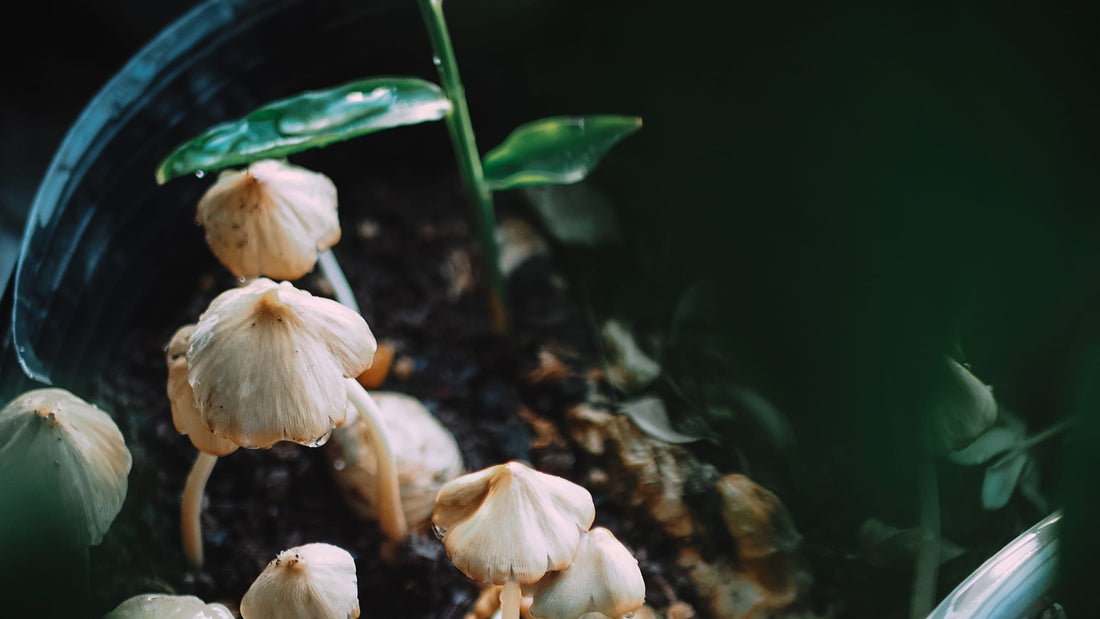Many plant owners notice mushrooms sprouting in their houseplant potting soil, often leading to confusion and concern. The most common reason for mushrooms to appear is the presence of spores in the soil, which thrive in moist, nutrient-rich environments. This phenomenon can be surprising, but it's important to understand that these mushrooms are usually harmless to the plants themselves and may even indicate a healthy soil ecosystem.
While mushrooms can pop up seemingly overnight, they signal certain conditions within the potting mix. Factors such as overwatering and poor drainage can create a perfect breeding ground for fungi. By recognising the conditions that encourage this growth, one can take steps to manage the issue effectively and maintain a healthier plant environment.
Addressing mushroom growth often involves simple maintenance strategies. Regularly checking moisture levels and ensuring proper drainage can help prevent future unwanted fungi. With this knowledge, plant owners can keep their greenery thriving without unnecessary worry.
Key Takeaways
- Mushrooms typically grow due to spores in moist, rich soil.
- Overwatering and poor drainage contribute to fungal growth.
- Simple maintenance can help prevent mushrooms in potting soil.
Understanding Mushroom Growth in Houseplants
Mushrooms can appear in houseplant potting soil due to various biological processes and the presence of specific fungi. Knowing about these fungi helps recognise their role in the ecosystem of the potting mix and how they can affect plant health.
The Biology of Mushrooms
Mushrooms are the fruiting bodies of fungi. They grow from mushroom spores, which spread through the air and settle in suitable environments, such as potting soil. Once they land in a moist, nutrient-rich area, they germinate and develop into mycelium. This mycelium is a network of thread-like structures that decomposes organic matter in the soil.
One common species found in houseplant soil is Leucocoprinus birnbaumii, also known as the flowerpot parasol. This mushroom can thrive in the nutrient-rich environment of potting soil, feeding on decaying plant material. While the presence of mushrooms might surprise some plant owners, they often indicate healthy soil conditions and a balanced ecosystem.
Common Types in Potting Soil
In addition to Leucocoprinus birnbaumii, several other types of fungi can be identified in houseplants. These include species that form beneficial relationships with plant roots, such as mycorrhizae. Mycorrhizae help plants absorb water and nutrients more effectively, fostering growth.
Mushrooms that sprout may not be harmful, but some can be toxic. It is essential to distinguish between harmless fungi and potentially dangerous ones. The appearance of mushrooms often suggests that the soil contains organic matter, supporting fungal growth and decomposition. Keeping an eye on mushroom growth can inform plant care and soil health.
Factors Contributing to Fungal Presence
Several factors influence the growth of mushrooms in houseplants' potting soil. Key aspects include watering habits, the composition of the potting mix, and environmental conditions such as humidity and temperature.
Overwatering Implications
Overwatering is a primary reason for fungal growth in potting soil. When soil remains consistently wet, it creates an ideal environment for fungi to thrive. Tropical houseplants, which prefer moist conditions, are particularly vulnerable.
Signs of overwatering include yellowing leaves and a soggy base. To mitigate this, one should ensure that pots have proper drainage. Allowing the soil to dry out slightly between waterings can also help. Proper watering habits play a vital role in preventing excessive moisture, ultimately reducing the chances of mushroom presence.
Importance of Potting Mix Composition
The composition of the potting mix significantly affects fungal growth. A mix rich in organic matter can encourage mushrooms. These materials provide nutrients for fungi and retain moisture, creating a conducive environment.
Choosing the right potting mix is crucial. He should select a well-draining mix that balances organic material with aeration components like perlite or vermiculite. This balance helps prevent compaction and excessive moisture retention. Updating the mix regularly can also limit fungal development and maintain plant health.
Encouraging Conditions: Humidity and Temperature
High humidity and warm temperatures also contribute to fungal growth. Most mushrooms thrive in environments with humidity levels above 60%. In tropical climates, this is often the norm, especially indoors where plants are kept.
Plant owners can monitor humidity levels using a hygrometer. If humidity is too high, employing a dehumidifier or ensuring proper air circulation can be beneficial. It is also essential to maintain a stable temperature, as fluctuations can promote fungal activity. Keeping houseplants in a well-ventilated area with controlled humidity and temperature can help limit the growth of unwanted mushrooms.
Prevention and Maintenance Strategies
Maintaining healthy houseplants involves careful attention to watering, soil selection, and routine care. Adopting these strategies can help prevent mushrooms from growing in potting soil.
Optimal Watering Practices
Proper watering is crucial for preventing excess moisture that leads to mushroom growth. It is important to water houseplants deeply but infrequently. This encourages roots to grow down into the soil, promoting better drainage.
Using pots with adequate drainage holes is essential. Without them, water can pool at the bottom, creating a perfect environment for fungi. Additionally, you should avoid letting water sit in the saucer beneath the pot.
It's beneficial to check the soil moisture before watering. A simple finger test helps determine if the top inch of the soil is dry. This ensures that the plant receives water only when needed, minimising the chance of excess moisture.
Soil and Pot Selection
Choosing the right soil is vital for houseplant health. A fertile potting mix that drains well will reduce the risk of mushrooms. Look for mixes that contain perlite or coarse sand, which improves aeration and drainage.
Selecting the correct pot also matters. Young plants may need pots that are deeper rather than wider to support root growth. Make sure the pot has sufficient drainage holes to allow excess water to escape effectively.
It is advisable to avoid reusing old potting soil with a known mushroom problem. Fresh soil helps eliminate existing spores, reducing the chances of mushrooms returning.
Routine Plant Care
Routine care helps keep houseplants healthy and less attractive to fungi. One key practice is regularly removing dead leaves and debris from the surface of the soil. This reduces organic matter that can promote mushroom growth.
You can also use an inert mulch to cover the potting soil surface, just like our Soil Topper, to try to control its reappearance.
Monitoring humidity levels in the home can also help. High humidity, especially in poorly ventilated areas, creates an ideal environment for mushrooms. Using a dehumidifier can help maintain balanced humidity levels.
Regularly inspecting the plant for signs of mushrooms or other fungi will allow for timely intervention. Promptly removing any visible mushrooms helps to prevent spores from spreading to other plants.
Removing Unwanted Mushrooms
Mushrooms can appear in houseplant soil due to moisture and organic matter. Removing them is essential to prevent further growth. There are various methods to effectively handle this issue.
Physical Removal Techniques
The simplest way to address unwanted mushrooms is through physical removal. When mushrooms first appear, it is crucial to remove the caps as quickly as possible. This action helps eliminate the spores that could lead to further growth.
Using tweezers or gloves, you can gently pull out the entire mushroom, ensuring that the stem is also removed. Scraping the soil is another effective method. Removing the top 2 inches (5 cm) of soil can help reduce spore presence. After this, replacing the soil with fresh potting mix can further deter future growth. Regular inspection and prompt removal are vital to managing this problem.
Natural and Chemical Fungicides
In some cases, natural or chemical fungicides may be necessary to manage mushroom growth. Neem oil is a popular natural remedy that can be applied to the distressed soil. It disrupts the life cycle of the fungi without harming the houseplant.
Another solution is using a baking soda mixture. Mixing one tablespoon of baking soda with water creates a spray that can help combat fungal issues. You can also spread a little cinnamon over the entire surface of the potting soil, and cover it with our Soil Topper, to try to control its reappearance. This can be applied to the soil where mushrooms are growing.
Frequently Asked Questions
Mushrooms in houseplant potting soil can raise many questions for plant owners. Understanding their presence, effects, and how to manage them is essential for maintaining healthy indoor plants. The following sections address common concerns related to mushrooms in potted plants.
Is the presence of mushrooms in potted plants an indication of poor soil health?
Mushrooms do not necessarily mean the soil is unhealthy. They often thrive in rich, organic soils, which can benefit plants. Their presence can indicate a healthy ecosystem of microorganisms in the soil.
How can one eliminate mushrooms from houseplant pots effectively?
To remove mushrooms, one option is to scrape the top 2 inches of soil and replace it. However, this may only provide temporary relief, as mushrooms can regrow. Changing the potting soil entirely may offer a more permanent solution.
Are white mushrooms found in potted plants a sign of toxicity?
White mushrooms in houseplant soil do not automatically indicate toxicity. While some mushrooms can be harmful, many are harmless. It is essential to identify the specific type before taking any action.
What does the emergence of mushrooms in indoor plant soil suggest?
The emergence of mushrooms suggests that the soil is moist and rich in organic matter. This environment encourages the growth of fungi. While they may not look appealing, they often highlight a thriving soil ecosystem.
Can the appearance of mushrooms in potted plants be a symbol of good fortune?
In some cultures, mushrooms are viewed as symbols of good fortune. This belief varies widely, but for many, mushrooms represent a connection to nature. It is a positive sign of natural processes at work.
What leads to the growth of mushrooms in potting soil, both indoors and outdoors?
Mushrooms typically grow in moist conditions with decaying organic material. Overwatering plants can create a damp environment that supports their growth. Additionally, spores present in the soil can sprout when conditions are favourable.

